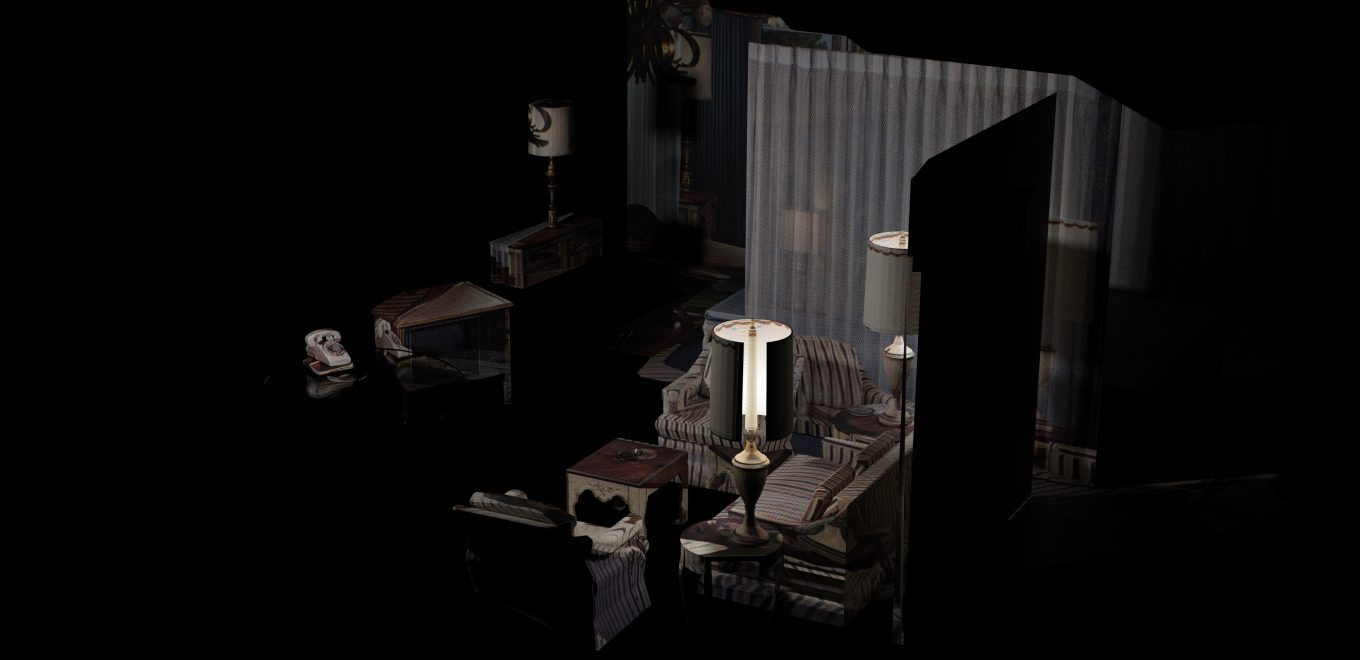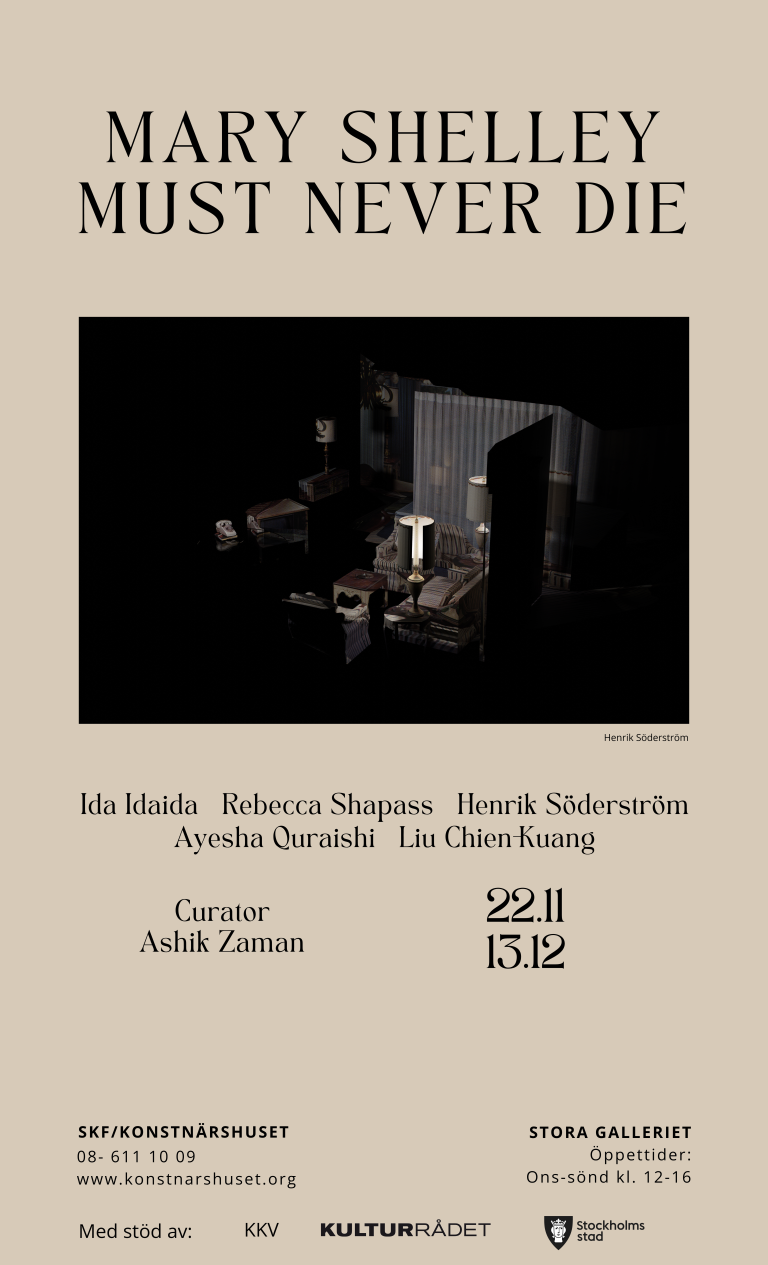
Mary Shelley Must Never Die
- 22 nov – 13 dec
- Stora galleriet
Ida Idaida, Rebecca Shapass, Henrik Söderström, Ayesha Quraishi, Liu Chien-Kuang
For English, please see below
Medverkande konstnärer:
Ida Idaida, Rebecca Shapass, Henrik Söderström, Ayesha Quraishi, Liu Chien-Kuang
Curator: Ashik Zaman, konstnärlig ledare SKF/Konstnärshuset
Tekniker: Arne Widman
Öppettider: ons-sönd kl. 12-16
Vernissage 22/11 kl. 13-16
Goth som en mångfacetterad genre inom kulturen kan sägas ta sikte på ett samspel mellan mörkare stämningar, sinnliga såväl som visuella, skönhet, skräck och det underliga och ockulta. Ofta inryms existentiell intensitet kring liv och död. Estetiken kopplas romantiskt till en fascination för det dystra och “förbjudna”. Goth föddes enligt utsago under det sena 1700-talet genom litteraturen, där Bram Stoker och Mary Shelley var tidiga ursprungsgestalter. Den senare är högaktuell igen genom en uppmärksammad och hyllad filmatisering.
Utställningen Mary Shelley Must Never Die utgår från intresset att blicka på och rikta ljuset mot goth som genre. Detta sker genom konstnärer som tydligt rört sig i fältet, men även konstnärer som genom utställningen fått söka sig närmare det. Oavsett vad den icke invigde upplever sig veta om goth uppstår säkert instinktiva föreställningar och förväntningar om vad som kan väntas i en framställning i genren. Förhoppningen här är en suggestiv utställning som vilar på vissa grundläggande element i genren.
År 1997 gjordes den uppmärksammade utställningen Gothic: Transmutations of Horror in Late Twentieth Century Art på ICA Boston. Den kom att förknippas med ett återuppsving för goth och skräck i kulturens eter under det sena 1990-talet, samt med de underliggande rädslor som omgav det förestående millennieskiftet. Skräckgenren inom filmen var starkt närvarande, liksom ett mörkare uttryck i mainstreamrocken.
Utställningen utgick från intresset att rama in genren från samtidskonstens fönster. I sammanhanget lyftes konstnärer såsom Dinos och Jake Chapman, Gregory Crewdson, Robert Douglas Gordon, Mike Kelley, Abigail Lane, Tony Oursler och Cindy Sherman. Utställningen har på sin höjd varit ett nyfiket bollplank som tillfört stoff att fundera kring.
Om goth som genre inom kulturen har Dr. Tracey Fahey, som forskat kring just goth inom bildkonsten, framfört:
”Gothic as a mode never exists in a vacuum… Historically, formulations and re-formulations of the Gothic are associated with crisis and periods of uncertainty in history.”
Hennes tes är att just samhällelig osäkerhet och turbulens har en förmåga att blossa upp goth som genre. Skräck som ett visst tematiskt inslag inom goth, med ett utrymme även i utställningen, har ofta nedvärderats som ”fulkultur” tidigare. Mer och mer tycks även skräcken åtnjuta en mer vördnadsfull blick. Ord som skräck och ”body horror” har nyligen kunnat noteras i recensioner och pressreleaser avseende kulturscener nära mig.
Kanske har också andra på sina håll tänkt att goth har ett särskilt ögonblick i kulturen.
Text: Ashik Zaman, konstnärlig ledare SKF/Konstnärshuset
SKF/Konstnärshuset har stöd från Kulturrådet och Stockholms stad.
Stort tack till KKV och Index!
///English version
Goth as a multifaceted genre within culture explores an interplay between darker moods, both sensual and visual, beauty, horror, and the uncanny and occult. It often carries an existential intensity around life and death. The aesthetic is romantically linked to a fascination with the dreary and the “forbidden.” Goth is said to have been born in the late eighteenth century through literature, with Bram Stoker and Mary Shelley as early progenitors. The latter has once again just now become strikingly relevant through a widely anticipated film adaptation.
The exhibition Mary Shelley Must Never Die departs from an interest in observing and illuminating goth as a genre. This is achieved through artists who have clearly moved within this field, but also through those who, in the context of the exhibition, have been invited to approach it more closely. Regardless of what the visitor may believe they know about goth, instinctive images and expectations surely arise about what a presentation within the genre might bring forth. The hope here is for a suggestive exhibition resting on certain foundational elements of the genre.
In 1997, the notable exhibition Gothic: Transmutations of Horror in Late Twentieth Century Art was presented at ICA Boston. It came to be associated with a renewed surge of goth and horror in the cultural ether of the late 1990s, as well as with the underlying fears surrounding the approaching turn of the millennium. The horror genre in film was strongly present, as was a darker tone in mainstream rock.
That exhibition stemmed from an interest in framing the genre through the lens of contemporary art. In its scope, artists such as Dinos and Jake Chapman, Gregory Crewdson, Robert Douglas Gordon, Mike Kelley, Abigail Lane, Tony Oursler, and Cindy Sherman were highlighted. At most, the exhibition has served as sounding board, contributing material for reflection.
On goth as a cultural genre, Dr. Tracey Fahey, who has researched goth in visual art, has stated:
“Gothic as a mode never exists in a vacuum… Historically, formulations and re-formulations of the Gothic are associated with crisis and periods of uncertainty in history.”
Her argument is that social instability and turbulence have the ability to reignite goth as a genre. Horror, as a particular thematic element within goth and one that also finds space in this exhibition, has long been dismissed as “low culture.” More and more, however, horror seems to be regarded with a renewed sense of respect. Words such as “horror” and “body horror” have recently appeared in reviews and press releases relating to cultural stages close to me.
Perhaps others, too, have sensed that goth is now enjoying a particular moment in culture.
